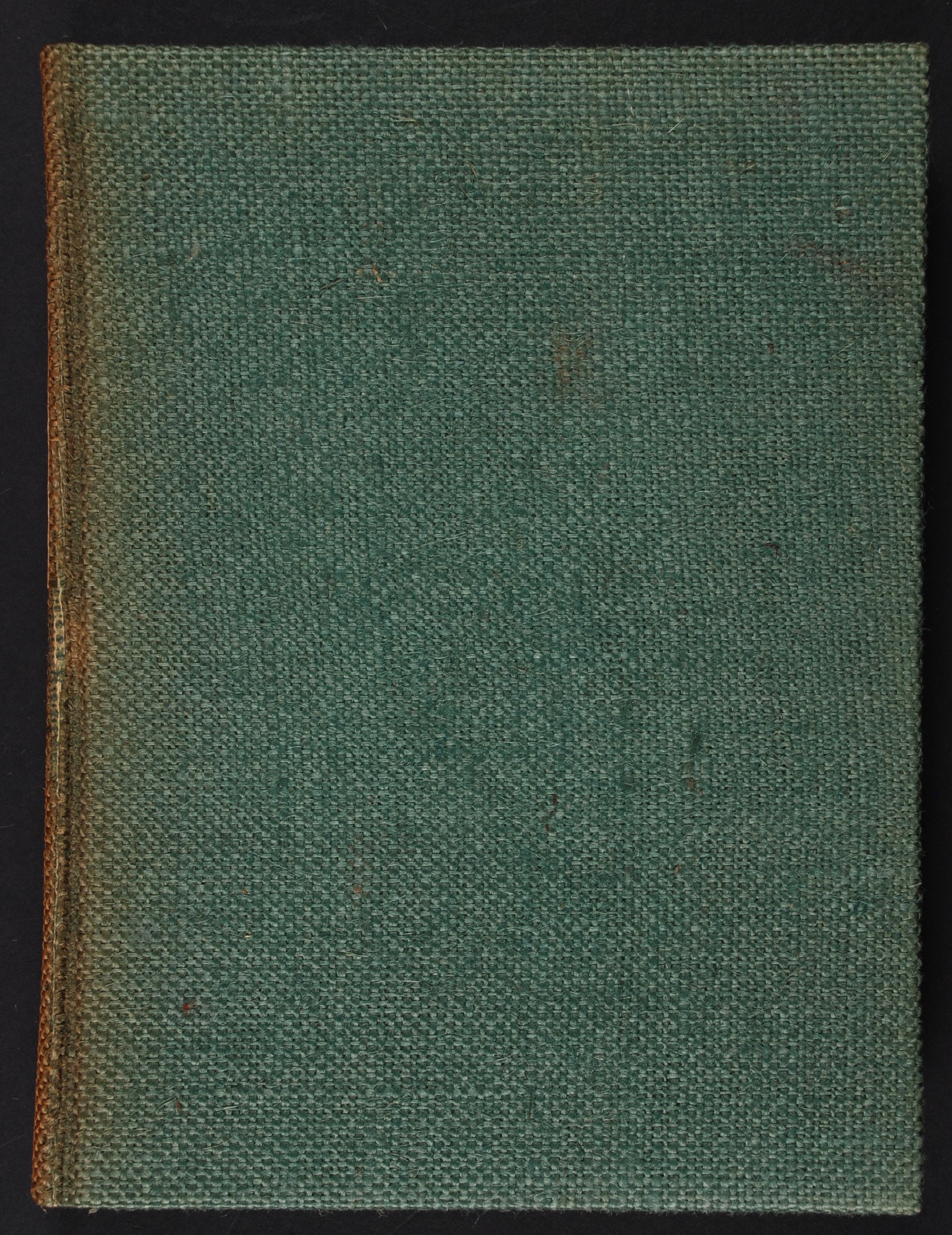Case W4
- Velvet, Hemp, and Dos-a-dos Bindings

A glance at the Grimani Breviary preserved in S. Mark's Library Venice. English edition. Venice: Ferdinand Ongania, 1903.
Books bound in velvet were most commonly found in England between 1500 and 1670, and were usually prayer-books. This book bound in red velvet with a gold-stamped medallion and portrait on the front cover is an Italian produced facsimile made for the English market in 1903, and limited to 500 copies.

A glance at the Grimani Breviary preserved in S. Mark's Library Venice. English edition. Venice: Ferdinand Ongania, 1903.
Open image in new window
![Psalmebog eller en Samling af gamle og nye Psalmer. Christiansand [Norway]: Trykt hos O.P. Moe, og paa hans Forlag af S.A. Steen, [1828?]](https://www.reedgallery.co.nz/__data/assets/image/0014/601205/W4b.JPG)
Psalmebog eller en Samling af gamle og nye Psalmer. Christiansand [Norway]: Trykt hos O.P. Moe, og paa hans Forlag af S.A. Steen, [1828?]
A dos-a-dos or ‘back to back’ binding occurs when two books are bound as one with a shared middle board and the fore-edge of one is adjacent to the spine of the other. Dos-a-dos bindings were mainly in vogue in England around 1600 to 1640. The example on display is a Norwegian hymnbook joined with a Lutheran prayer-book and Psalms, published in Christiansand about 1828. The leather is contemporary calf, with the letters ‘HGS’ stamped on the front board.
![Psalmebog eller en Samling af gamle og nye Psalmer. Christiansand [Norway]: Trykt hos O.P. Moe, og paa hans Forlag af S.A. Steen, [1828?]](https://www.reedgallery.co.nz/__data/assets/image/0014/601205/W4b.JPG)
Psalmebog eller en Samling af gamle og nye Psalmer. Christiansand [Norway]: Trykt hos O.P. Moe, og paa hans Forlag af S.A. Steen, [1828?]
Open image in new window
![Psalmebog eller en Samling af gamle og nye Psalmer. Christiansand [Norway]: Trykt hos O.P. Moe, og paa hans Forlag af S.A. Steen, [1828?]](https://www.reedgallery.co.nz/__data/assets/image/0015/601206/W4bb.JPG)
Psalmebog eller en Samling af gamle og nye Psalmer. Christiansand [Norway]: Trykt hos O.P. Moe, og paa hans Forlag af S.A. Steen, [1828?]
A dos-a-dos or ‘back to back’ binding occurs when two books are bound as one with a shared middle board and the fore-edge of one is adjacent to the spine of the other. Dos-a-dos bindings were mainly in vogue in England around 1600 to 1640. The example on display is a Norwegian hymnbook joined with a Lutheran prayer-book and Psalms, published in Christiansand about 1828. The leather is contemporary calf, with the letters ‘HGS’ stamped on the front board.
![Psalmebog eller en Samling af gamle og nye Psalmer. Christiansand [Norway]: Trykt hos O.P. Moe, og paa hans Forlag af S.A. Steen, [1828?]](https://www.reedgallery.co.nz/__data/assets/image/0015/601206/W4bb.JPG)
Psalmebog eller en Samling af gamle og nye Psalmer. Christiansand [Norway]: Trykt hos O.P. Moe, og paa hans Forlag af S.A. Steen, [1828?]
Open image in new window
![The Book of Common Prayer … together with, The Psalter or Psalms of David … Oxford: University Press, [189-?]. Bound with: Hymns ancient and modern .... London: William Clowes, [189-?]](https://www.reedgallery.co.nz/__data/assets/image/0016/601207/W4c.JPG)
The Book of Common Prayer … together with, The Psalter or Psalms of David … Oxford: University Press, [189-?]. Bound with: Hymns ancient and modern .... London: William Clowes, [189-?]
This is a nineteenth century dos-a-dos embroidered binding in the seventeenth century Dutch style. The pale green cloth is ribbed with silver thread, and the sides feature large stylized tulips surrounded by beads. The backstrips are divided by gold thread, with a four-petalled flower in each compartment; with endpapers of ribbed light blue silk.
Embroidered bindings were present throughout sixteenth century England, into the first half of the seventeenth century, when there was a considerable vogue for small format devotional books with embroidered covers.
![The Book of Common Prayer … together with, The Psalter or Psalms of David … Oxford: University Press, [189-?]. Bound with: Hymns ancient and modern .... London: William Clowes, [189-?]](https://www.reedgallery.co.nz/__data/assets/image/0016/601207/W4c.JPG)
The Book of Common Prayer … together with, The Psalter or Psalms of David … Oxford: University Press, [189-?]. Bound with: Hymns ancient and modern .... London: William Clowes, [189-?]
Open image in new window
![The Book of Common Prayer … together with, The Psalter or Psalms of David … Oxford: University Press, [189-?]. Bound with: Hymns ancient and modern .... London: William Clowes, [189-?]](https://www.reedgallery.co.nz/__data/assets/image/0017/601208/W4cc.JPG)
The Book of Common Prayer … together with, The Psalter or Psalms of David … Oxford: University Press, [189-?]. Bound with: Hymns ancient and modern .... London: William Clowes, [189-?]
This is a nineteenth century dos-a-dos embroidered binding in the seventeenth century Dutch style. The pale green cloth is ribbed with silver thread, and the sides feature large stylized tulips surrounded by beads. The backstrips are divided by gold thread, with a four-petalled flower in each compartment; with endpapers of ribbed light blue silk.
Embroidered bindings were present throughout sixteenth century England, into the first half of the seventeenth century, when there was a considerable vogue for small format devotional books with embroidered covers.
![The Book of Common Prayer … together with, The Psalter or Psalms of David … Oxford: University Press, [189-?]. Bound with: Hymns ancient and modern .... London: William Clowes, [189-?]](https://www.reedgallery.co.nz/__data/assets/image/0017/601208/W4cc.JPG)
The Book of Common Prayer … together with, The Psalter or Psalms of David … Oxford: University Press, [189-?]. Bound with: Hymns ancient and modern .... London: William Clowes, [189-?]
Open image in new window

Walt Whitman. Leaves of grass. New York: Doubleday, Doran & Co., 1940.
This edition of Walt Whitman's Leaves of Grass is bound in green-dyed hemp or hessian, a dense woven fabric.


![Psalmebog eller en Samling af gamle og nye Psalmer. Christiansand [Norway]: Trykt hos O.P. Moe, og paa hans Forlag af S.A. Steen, [1828?]](https://www.reedgallery.co.nz/__data/assets/image/0014/601205/W4b.JPG)
![Psalmebog eller en Samling af gamle og nye Psalmer. Christiansand [Norway]: Trykt hos O.P. Moe, og paa hans Forlag af S.A. Steen, [1828?]](https://www.reedgallery.co.nz/__data/assets/image/0015/601206/W4bb.JPG)
![The Book of Common Prayer … together with, The Psalter or Psalms of David … Oxford: University Press, [189-?]. Bound with: Hymns ancient and modern .... London: William Clowes, [189-?]](https://www.reedgallery.co.nz/__data/assets/image/0016/601207/W4c.JPG)
![The Book of Common Prayer … together with, The Psalter or Psalms of David … Oxford: University Press, [189-?]. Bound with: Hymns ancient and modern .... London: William Clowes, [189-?]](https://www.reedgallery.co.nz/__data/assets/image/0017/601208/W4cc.JPG)
